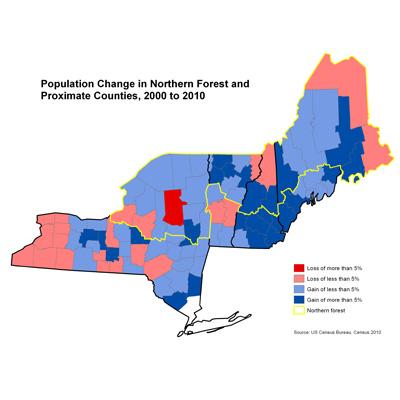The Implications of Demographic Change for Resource Management in the Northern Forest

The future of the Northern Forest and its communities depends on the ability to anticipate change and respond appropriately. Natural resources respond to change slowly and benefit from long-range planning and management. Demographic analysis provides a powerful tool for finding sustainable solutions for communities of the Northern Forest. NSRC researchers combined demographic data from the U.S. Census with economic, spatial, and forest data to investigate population redistribution trends. They compared trends in the 34 Northern Forest counties to that in 58 nearby non-Forest counties.
In 2010, 2,289,000 people resided in the Forest counties. Population gains were greater in these counties (3.4%) than in the non-Forest counties (2.3%). Both natural increase (births - deaths) and migration contributed to the modest population gain in the Northern Forest. Northern Forest counties gained migrants between 2000 and 2010, rather than losing them as they had during the 1990s. The inflow of migrants was particularly significant in high amenity counties where population gains were the greatest. In contrast, population gains were smallest in manufacturing counties, where migration gains were minimal.
The Northern Forest population is growing older due to aging of current residents and because it is losing young adults and gaining older adults from migration. Racial diversity is increasing with children in the forefront of this change. The housing stock has grown modestly over the last several decades, yet forests remain widespread, even in areas with moderately high housing densities. These changes have produced an extensive intermix of people and forest that resource managers must be cognizant of in planning for the future of the region.
Download printable version [PDF]
Download full final report [PDF]
